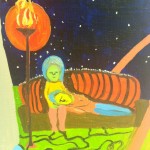Lines a mile long, extreme coupon hunting, and if there’s not a sale… Well than you may as well shut down for the months of November and December. That’s right, folks… It’s the Holiday season. And no matter how long you’ve worked at your place of employment, and no matter the precautions that led you to this time of year… Nothing will help prepare you for the chaos you are about to endure. How do I know this? Because for the first time this year, I was given the opportunity to partake in my first every Black Friday, or as retail refers to it “Green Friday,” experience.
“Jazz, clock in and hop on cash registers,” my boss tries to yell over the pulsating music and the chatter of customers shopping in our store.
It was 4pm on Black Friday. The mall had opened at midnight (16hrs earlier), and the sale we were having had started the day before Thanksgiving (2 days prior). Yet we already had a line forming around the store. I hadn’t even been in there for more than 10 seconds and I was already being ordered around.
I clock in, and hurry to the back room to grab my headset and nametag. I put my purse in my locker, and I head back out to the sales floor where I will embrace my fate at the ever-demanding cash register.
“It’s our biggest day of the year guys, let’s make sure we talk to every single customer!” my boss says as her voice can now be heard in my right ear thanks to my headset.
I take my post at cash register two.
“Hey, how are you doing today?” How I start 9 out of 10 conversations with customers.
“Good, good,” says the woman, “How are you?”
“Great! Getting all of your Christmas shopping done?” I ask.
We were taught to always be “friends first” with the customers, have real conversations, etc. So I try, although I’ll admit, I say pretty much the same lines over and over. It’s repetitive, but how many different ways can you really address a complete stranger?
“Sure am! Just have a few things left on my list, and this will all finally be over,” the woman laughs.
I shoot her a smile. I haven’t even started Christmas shopping. Is that pathetic?
The woman begins fishing around in her purse.
“I think I might also have a coupon around her somewhere… Didn’t you guys just send out a coupon recently?” the woman asks.
The entire store is 40% off this particular weekend for the big “Black Friday” sale, mind you.
“I don’t believe so… Our entire store is 40% off this weekend, so I doubt they would send out another coupon on top of that,” I try to say with my best customer smile I can work up. But really, this woman is asking for another coupon? She’s getting what a normal employee gets as a discount on a regular basis. That doesn’t happen often, and she’s complaining?
The woman is unhappy. I can tell by the way she begins to scrunch her face up. I try to think of something as quickly as possible.
“If you would like to sign up for our store charge card today I can save you 55% instead of the 40% everyone is saving,” I say.
Her eyes light up.
I’ve done it.
“Oh, alright! Let’s try that!” She’s ecstatic.
I typically hate pushing the charge cards onto people. I have my own reserved feelings about them, but the things people will do for a coupon these days.
I finished ringing the woman up, and sent her on her way having only paid 45% instead of the of the 60% a majority of other people were paying.
It didn’t stop there, though.
I stayed in that line, in the EXACT same spot for 3 hours. The flow of customers was constant through the cash register line, and almost every other person brought up the concern of more coupons.
It was like that book I read as a child, If You Give a Mouse a Cookie. In this book the Mouse is given a cookie, but then it wants milk, and so on and so forth until it’s asked for just about everything.
These people were coupon crazed even after we were giving them the best deal we had had all year!
Finally 9pm rolled around, and I was the first to sprint to the front of the store to close the doors.
“We did it guys! We survived Black Friday! You all were great!” exclaimed my manager over our headsets. Then she started rattling off statistics for the sales we had accomplished that day.
The store was a mess, my feet hurt from standing, and I was scheduled for at least two more hours to help clean the store up. My first Black Friday in retail, and the last 6-letter word I ever wanted to hear again was “coupon.”





